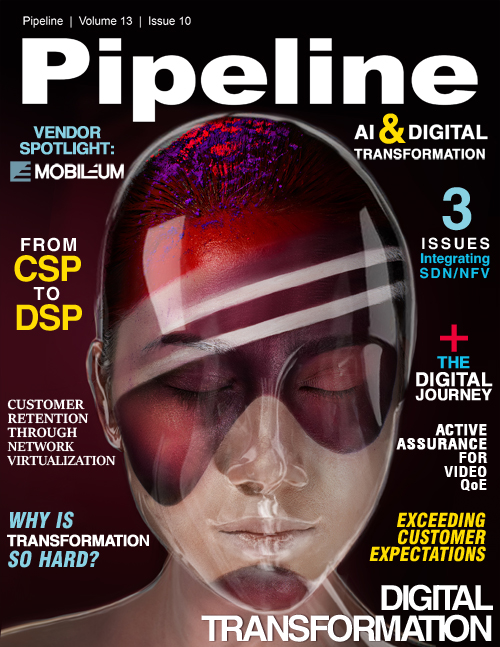Exceeding Customer Expectations Shaped by Digital Disruption
By: Chad Dunavant

Digital transformation has introduced a whole new caliber of connectivity to consumers’ daily routines. Amazon’s Alexa can pull up a recipe for the buffalo dip your best friend texted you about, turn on your oven for the dip preparation – and then order you an Uber so you can bring the delicious end-result to your friend’s house before half-time of tonight’s game. Once your Uber arrives, you can stream the nail-biting game on your smartphone, picking up from the exact second that you stopped watching on your TV. The digitally-driven customer experience – and corresponding expectations – have become more sophisticated across all industry verticals. Service providers are not exempt from this transformation. They are uniquely positioned to become the epicenter of it. Delivering a unified, personalized and data-driven customer experience should be the three key focus areas for service providers as they aim to stay ahead of the expectations of the digital consumer.
A unified hub – for everything
Ease of navigation and access to content has become critical to the customer experience of today’s consumer. Viewers don’t want to be burdened with separately searching their cable catalog, Netflix, HBO Go and Hulu accounts to find out which service has season three of their favorite show. Alternatively, they want a central search location that brings all of their recommended and stored content together. The industry has heard this expectation loud and clear, ushering in a new phenomenon of Pay-TV/OTT co-opetition. The first unexpected partnership between Comcast and Netflix sparked a great deal of shake-up across the cable landscape in 2016. This year, social media and tech giants are emerging as major competitors – and potential partners – to Pay-TV players. For example, last season, the NFL’s Thursday Night Football got an unexpected new home – Twitter. Then, last month, Amazon joined the live sports streaming arena winning the rights to stream 10 Thursday night football games for the 2017 season through a $50 million, one-year deal.
A centralized hub for access to premium, original and live video content – able to be accessed anywhere, anytime, from any device – is now not only an expectation, it’s the industry norm. As content aggregation becomes a mainstream goal for service providers IoT has evolved into the next frontier for digital operators to grow this concept of a unified hub. Service providers who are looking to exceed the expectations of today’s consumers cannot solely focus on aggregating video content for a unified viewing experience; they also need to deliver a unified billing service. Consumers interact with their subscriber accounts across devices and communications channels, making it essential for account information to appear clearly and consistently – whether delivered as a PDF statement or a simple mobile-friendly summary of charges. The customer demand for a universal hub presents service providers with the opportunity to create more value in personalized bundles and discount schemes that are only available when you own the customer, the channels, and the aggregated content. Operators who are able to transcend platform-specific content silos will create unique merchandising schemes to attract – and more importantly, retain – new customers. To exceed the IoT-driven customer experience shaped by today’s digital era, and leverage the next frontier of the digital transformation, service providers are presented with the unique opportunity to develop the universal language needed for IoT devices to speak to each other. Forward-looking providers will be tasked with creating an infrastructure that enables them to “own the home." This would spark the role of service providers to evolve from a content aggregator into a device-agnostic, interactive platform for smart dishwashers, thermostats, washing machines, and of course, video content. Lifestyles enabled by IoT have become the norm with the next generation and, therefore, with the next generation of consumers. Service providers cannot afford to fall behind IoT disruptions and smart device interactions. To stay ahead, they must power them, and create an aggregated ecosystem of connectivity across platforms. To do this, their businesses, systems, and processes need to be open, allowing third party devices to connect, interact and share data through a data driven ecosystem. Services will become tailored to the consumers they support, learning behaviors and routines to fit the lifestyles of these consumers. Comcast is among the first providers aiming to “own the home” – kick started by the recent acquisition of Icontrol Networks for the company’s IoT technology – and they certainly won’t be the last.
An elevated caliber of personalization
In the past, offering a personalized customer experience meant delivering subscription offerings to a single head of household account holder. In today’s digital era, service has to meet individuals within a household wherever they are, across devices, with multiple payment methods and billing options. The digital transformation has caused “personalization” to take on a whole new meaning – evolving it into one of the main competitive differentiators between service providers in today’s increasingly crowded and innovative market.
Within this new era of personalization, service providers and operators need to think out-of-the-box when looking to attract and retain the digitally savvy subscriber. In tandem, and possibly most critical, service providers need to regularly ask themselves, “what’s next?” So, now that offering video and billing content in one central repository for the on-the-go, digitally savvy consumer has become the standard of customer service – what’s next?



















